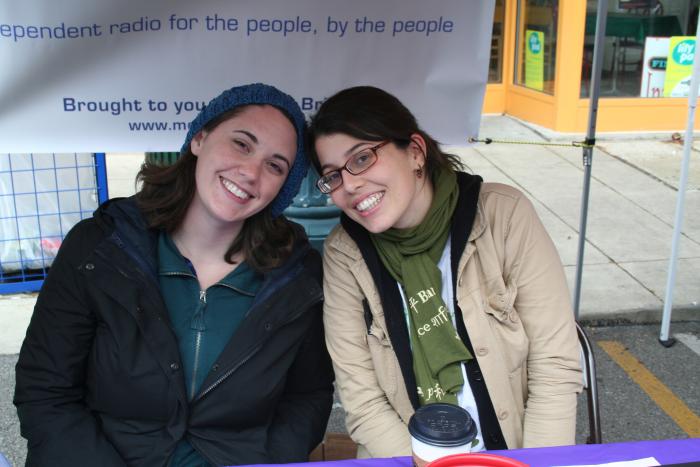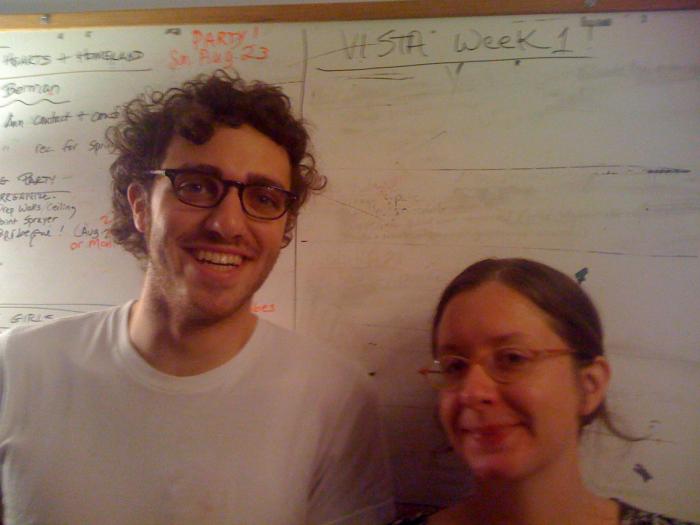
Leveraging a Little for Maximum Impact: The Digital Arts Service Corps and a New Structure for Public Media Engagement
By Patricia R. Zimmermann, Ph.D.
Professor, Cinema, Photography and Media Arts at Ithaca College
Here’s a recession fantasy: Imagine a small amount of money—less than half the cost of a new Prius car—that could increase organizational effectiveness, catapult nonprofits into social media, augment visibility on a national scale, train staffers in new technologies, transform local communities and propel civic engagement.
Impossible?
No.
Now imagine that fantasy in action. A small investment of $11,000 to $14,000 leverages maximum impact that not only strengthens civil society in local communities but connects emerging public media partisans with established staff. It’s intergenerational. It’s sustainable. It’s focused on concrete outcomes.


The Digital Arts Service Corps (DASC) and the Transmission Project grab this fantasy and then materialize it in communities across the United States. DASC is an initiative of the Transmission Project, a grantee of the Massachusetts state office of the Corporation for National and Community Service. It is located at the College of Public and Community Service at the University of Massachusetts, Boston.
Digital Arts Service Corps members work with nonprofit groups—both public media and other organizations that use media—to strengthen delivery of core services. DASCorps members contribute skills and knowledge in website building, technical programs, board development, fundraising, managing volunteers and other capacity-building activities. The goal of DASCorps members: sustainable organizational change.
Meet Patrick Castrenze. After studying communications and landscape architecture at Cornell University, he became fascinated with what he dubs “bottom up perspectives.” Twenty-six years old, Castrenze wanted a job working in a media arts organization with a strong commitment to people telling their own stories with new tools.
But the bad economy derailed him. So he applied to the Transmission Project, got accepted, and was placed with the Center for Digital Storytelling in San Francisco. He’s spending a year there helping to assemble an archive for the 6,000 pieces of “bottom up stories” that have been generated. He’s also working to figure out how all of these stories can be more accessible to facilitators of the Center’s workshops.
“It’s really exciting at the Center for Digital Storytelling,” he effuses. “I’m with a bunch of passionate individuals all day long—writers, sculptors, theater people, journalists, with a lot of different perspectives, but with a compassion for listening to people.”
Rather than funding a piece of media, it’s a model underwriting advocacy, infrastructure, youth development, community transformation and civil society. In an era when social media is being cannibalized and corporatized, the Transmission Project’s corps members are wresting away control and infusing it with a public interest direction through a solid investment in time.
The US spends only $1.37 per person for public media, compared to Canada’s $22 per person, England’s $80 per person. By comparison, the US spent $565 per person to bail out AIG.
“The Digital Arts Service Corps is a small investment to cause exponential change in communities,” offers Belinda Rawlins, executive director of the Transmission Project.
Members of the DASC, who must be at least 18 years old, receive a stipend ranging from $11,000 to $14,000. Student loans are deferred for the year of service. At the end, they can opt for a cash award of $1,000 or an educational award of $5,300.
Consider this metric: an average theatrical documentary costs about $750,000 and five years of time. Fifty-three DASC corps members—mostly young people—could be funded for one solid year of work with nonprofits for this same price tag.
Consider another figure: many small microbusinesses and nonprofit media centers can easily spend $11,000-$14,000 a year for website development, marketing, communications strategy design and social media campaigns, all outsourced. But a DASC corps member works within these public media organizations for a year, providing services with impact and measurable outcomes.
Idealware is a small organization in Maine that evaluates software for nonprofits. As executive director Laura Quinn observes, it’s a daunting, overwhelming job to keep track of not only software but social media.
All that changed when DASCcorp member Kaitlin LaCasse arrived in August. A graduate of Colgate University with a double major in Political Science and Spanish, Kaitlin, with financial sector experience, was looking to learn more and to give back. At Idealware, she’s developing research and best practices for nonprofit social media strategies.  “I find it really exciting to think about developing a communications strategy for social media,” she says. “A lot of people want to jump on the bandwagon without thinking it through. Many nonprofits don’t have the time, money or manpower to figure out social media—media that allows interaction.”
“I find it really exciting to think about developing a communications strategy for social media,” she says. “A lot of people want to jump on the bandwagon without thinking it through. Many nonprofits don’t have the time, money or manpower to figure out social media—media that allows interaction.”
The Transmission Project, housed at the University of Massachusetts-Boston, matches Digital Arts Service Corps (DASC) members with public media organizations. Its motto is “amplify the power of public media and technology.”
A 2009 Tulane University graduate from Maryland, Kelsey Parris embodies this motto. The Transmission Project placed her with the Southern Food and Beverage Museum in New Orleans, which preserves the cultural foodways of minority cultures of the American south. Parris maintains their webpage and augments their online visibility. “It’s a great experience to help a small organization,” says Parris.
The range of organizations where DASC members work demonstrate the depth, breadth, impact and yes, redefinition of the public media field in local communities. There’s the Academy for Career Development in Rochester, New York, that provides “educational opportunities for disabled, disadvantaged and displaced children, youth and adults.” And the Grand Rapids Community Media Center, which uses media to tell stories from Western Michigan. And the New Mexico Media Literacy Project, which cultivates critical thinking about media culture.  The range of Digital Arts Service Corps placements suggest that the public media field could benefit from expanding its definition of a media organization to include institutions that use media to deliver their services and messages more effectively.
The range of Digital Arts Service Corps placements suggest that the public media field could benefit from expanding its definition of a media organization to include institutions that use media to deliver their services and messages more effectively.
A good example is the Minnesota Legal Services Coalition, a state-supported center providing civil legal service. Staffer John Freeman describes how their DASC corps member is adapting a software program to help low-income people and attorneys create efficiencies and build legal knowledge through more automated court forms. The Vista worker can focus on this difficult and time-consuming task. And the software system will live on beyond the one-year appointment of the Vista worker, helping the Coalition to increase capacity.
“The goal of the Digital Arts Service Corps and the Transmission Project is to help organizations do more with less, to build infrastructure, and to have strength to withstand the economic downturn,” explained Rawlins.
Latinitas in El Paso, Texas, works with at-risk low-income youth to build confidence and express themselves through lessons on writing, graphic art, desktop publishing, web design, photography, filmmaking and radio production.
“So far I have helped in recruiting new club leaders for the clubs and setting up all the after-school programs' activities and locations,” shared Claudia Escobar, a DASCorps member.
President Obama signed the Edward M. Kennedy Serve America Act on April 21, 2009. The Act reauthorizes and expands national service programs to engage 4 million Americans. The passage of the Act garnered bipartisan support.
The goal is to expand AmeriCorps from 75,000 to 250,000 by 2017. According to a White House press release, applications this year to Americorps tripled from 2008. Demand has swelled for Americorps opportunities—and for DASC placements.
The need on both the applicant and the organizational end is enormous and pressing. This year, 130 nonprofit organizations applied for 45 spots. Eight hundred applicants applied for those 45 placements. Right now, more financial resources are required to meet the enormous demand in the struggling nonprofit sector for corps members and to accommodate eager applicants, where only one out of 17 will be selected.
Both Obama and McCain pushed for national service during the Presidential campaign. The Millennials, the tech-obsessed, digital natives generation born since 1979, to baby boomers, have embraced group-oriented community service. The 2008 economic collapse propelled layoffs, threatened the nonprofit media arts sector and dimmed the hopes of new college graduates for jobs with health insurance. Many unemployed workers have transferred their skills to the nonprofit sector.
“We’re building the next round of leaders for the field,” explains Rawlins. To this end, the Transmission Project runs a four-day orientation for new corps members on poverty in the United States and the role technology and media plays in moving people out of poverty and into the workforce.
They also provide roadmaps for how work happens on-site, budgeting, health care, expectations, project management and project outcomes. Organizations have the corps member for one year, contribute $3,500, and provide living assistance and opportunities for professional development at a national conference.
The Transmission Project emphasizes results: strong, sustainable organizations, professional growth, increased capacity in the media technology movement, new skills and innovative programs matched to community needs.
Instead of best practices, the Transmission Project offers artifacts dubbed “honest practices.” Artifacts offer a new media toolkit: a community radio manual, a guide to planning and running festivals, concerts and fundraisers, a windows/MAC translation guide, an iGoogle dashboard, a basic search engine optimization technique and Twitter guidelines and policies.
Patrick Castrenze views his corps experience not as a gap year in San Francisco, but as engagement with a field: “It’s exciting to think that we (the DASC corps) are the future leaders of digital media—we are the next generation coming up.”
# # # # #
Patricia R. Zimmermann is the author of Reel Families: A Social History of Amateur Film; States of Emergency: Documentaries, Wars, Democracies; and Mining the Home Movie: Excavations in Histories and Memories. She is professor of cinema, photography and media arts at Ithaca College. She also serves as co-director with Thomas Shevory of the Finger Lakes Environmental Film Festival. patty(at)ithaca.edu


